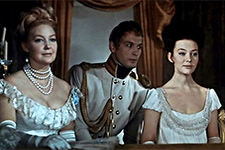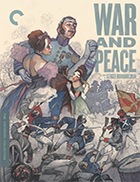War and Peace (Vojna i mir)
|  When one reads about Sergei Bondarchuk’s epic, state-sponsored adaptation of Leo Tolstoy’s 1869 novel War and Peace (Vojna i mir), a monumental work of literature if ever there were one, what one often first reads are the numbers. Shot in large-scale 70mm and running more than seven hours in length, Bondarchuk’s film is actually four separate films that, depending on the source, cost more than 8 million rubles, making it the most expensive Soviet film ever made—and possibly the most expensive film ever made (recent estimates suggest that it cost the equivalent of $700 million today, leading New York Times critic Dave Kehr to quip that its “insane expense” may have been one of the contributing factors to the collapse of the Soviet Union). One will read about how Bondarchuk was given free reign by government authorities to use actual historical relics from the state’s history museums and was afforded the use of military aircraft and 15,000 soldiers from the Soviet army. The film boasts 300 speaking roles and 120,000 extras, and its three massive battle sequences used 23 tons of explosives and 10,000 smoke grenades. It took six years to produce (interestingly, roughly the same amount of time it took Tolstoy to write his novel), and one of the film’s biggest set-pieces, the burning of Moscow by its own residents after the city fell to the French army, took 10 months to plan. And on and on. Of course, it’s hard to ignore all those attention-grabbing numbers because War and Peace is enormous, grandiose, epic in every sense; it’s the kind of film that sends you running to the thesaurus to find a word that somehow conveys its grandiosity. Its size is a major element of its raison d’être, as it was intended—much like the concomitant Space Race—as a challenge to supposed Western technological and artistic supremacy, proof positive that the Soviet film industry could turn out a Hollywood-style blockbuster that would dwarf Hollywood. In 1956, American director King Vidor had helmed an adaptation of War and Peace starring Peter Fonda and Audrey Hepburn that, while a flop stateside, was a huge hit in the Soviet Union (it was one of the first American films released as part of a new cultural exchange program between the U.S. and the USSR). For Russian cultural warriors, this was the ultimate insult: the greatest work of Russian literature adapted by the capitalist heathens of Hollywood. It had been decades since War and Peace had been the subject of a Russian film—not since the silent era, when there were no less than five. Set against the backdrop of the Napoleonic Wars of the early 19th century, War and Peace tells the interlocking stories of several prominent aristocratic families living in St. Petersburg. The three central characters are Pierre Bezukhov (Sergei Bondarchuk), the young, illegitimate son of a dying count who inherits his father’s wealth and is suddenly thrust into Russian high society; Andrei Bolkonsky (Vyacheslav Tikhonov), a handsome prince who is nevertheless disillusioned with his family life and jumps at the chance to go to war, where he has the opportunity to live up to the high ideals of his stern father (Anatoly Ktorov); and Natasha Rostova (Lyudmila Saveleva), a beautiful heiress who becomes the object of affection at different points for both Pierre and Andrei. To helm this massive undertaking, the Soviet state selected, much to the consternation of the film establishment, Sergei Bondarchuk, a popular actor who was the youngest ever, at age 32, to receive the honorary title of People’s Artist of the USSR. He had directed only one film, Destiny of a Man (1959), based on the novel by Mikhail Sholokhov, which had been well received commercially and critically (winning the Grand Prize at the 1st Moscow International Film Festival); but, as a relatively modest drama about a war veteran, it was hardly evidence of his ability to manage such a massive cinematic undertaking. Yet, the Soviet state had faith in him, partially because he was a dedicated nationalist who was personally insulted by Vidor’s film and therefore deeply invested in topping it. And one cannot say that Bondarchuk did not give it his all, both behind the camera and in front of it, as he also cast himself in the central role of Pierre Bezukhov, a decision for which he was roundly criticized (he turns in an excellent performance, but he was about 20 years too old for the part). Working with screenwriter Vasiliy Solovyov, Bondarchuk adapted Tolstoy’s novel with a great deal of fidelity, although as a director his chief virtue is his willingness to experiment with and mix styles, making the film decidedly cinematic, rather than just a slavish page-to-screen translation of Tolstoy’s words. He and Solovyov divided the story into four separate films, each of which has a distinctly different feel (although it was released in the U.S. in a shortened, six-hour version that was divided in half). The first film, Andrei Bolkonsky, is the longest of the four by almost an hour and plays like an epic unto itself, mixing familial drama and intrigue, romance, and war in equal measure; the second film, Natasha Rostova, is primarily a romantic melodrama, although it leads directly into the third film, The Year 1812, which is a brutal, brilliant war film. The final segment, Pierre Bezukhov, is the most philosophical, bringing together the various narrative threads against the backdrop of war’s fallout. The enormity of the narrative canvas gave Bondarchuk a great deal of room to work, and his seemingly endless state resources ensured that he never had to cut corners or minimize anything in Tolstoy’s novel. This incredible freedom allowed him to give the film both the depth and breadth it requires, and it is filled from end to end with stunning set-pieces and painterly images, exquisite camera movements and elaborate set design. Bondarchuk is deeply invested in the film’s sense of realism; even though it features numerous process shots and matte paintings, such effects never come at the expense of the film’s overall sense of intense physicality, whether that be on the battlefield or in the ballroom. Working with three credited cinematographers (two of whom left early on under duress), Bondarchuk keeps the camera constantly in motion, whirling around his characters, tracking them through room after room, and racing hectically through the violence of battle, sometimes from directly above. The movements are often smooth in a way that makes you wonder if the Soviets hadn’t somehow invented the Steadicam 10 years early, but Bondarchuk also deftly employs frantic, disorienting handheld camerawork to create a sense of chaos and unease. He throws in split screen effects, horizontal wipes, overlapping images, and even surreal dream imagery—anything that might work in the moment—and one of the real miracles of War and Peace is that it feels all of a piece, despite its vastly disparate aesthetic approaches. If there is a flaw here, it is that it sometimes feels like Bondarchuk is working too hard to impress us; the effort is a bit too palpable at times, which draws us out of the drama and lures us into admiring the spectacle on technical, rather than emotional terms. Yet, even when it’s obviously trying too hard, War and Peace is rarely less than magnificent and remains the kind of cinematic epic to which all others aspire.
Copyright © 2019 James Kendrick Thoughts? E-mail James Kendrick All images copyright © The Criterion Collection | |||||||||||||||||||||||||||||||
Overall Rating: 


 (3.5)
(3.5)


